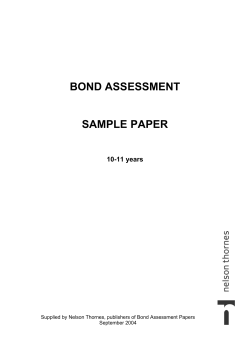
The Jet-Ready Precooler is an extremely powerful - Pre
TECH a recipe for cooling cherries E “ The jet coolers have brought our packed box cooling time down from 12 hours in 2011 to 2 hours today. ” very hour a cherry spends over 40 degrees equals one day of retail shelf life lost. Since 2011, Stemilt has been researching, testing, and implementing different tactics in order to decrease the amount of time any Stemilt cherry spends over the critical 40 degree threshold. According to Paul Esvelt, Stemilt distribution manager, the company’s production and shipping teams had an assumption in 2011 that better insight and knowledge of cooling cherries could create better results. The mission was simple – develop a recipe for cooling cherries in order to consistently deliver fresh, firm, and highquality cherries to destinations and consumers worldwide. 4 Hilltop • Issue#8 • Spring/Summer 2015 Spring/Summer 2015 • Issue #8 • Hilltop 5 The path to achieve the mission was filled with unknowns, but began with a look at packaging, and how it performed during the tunneling process that is used to cool packed and palletized cherries just before shipment. “We quickly learned that we weren’t pulling air through the boxes very well. Tunneling involves the process of forced air cooling, which is the ability to move cold air over a warm surface. Without the ability to pull that cool air through the box, it’s difficult to achieve consistent cooling of cherries,” said Esvelt. A big crop of cherries in 2013 unveiled another area where cooling could be improved. “Despite having a consistent box and pallet alignment in each tunnel, there was still variability and inconsistencies in the amount of time it took to cool cherries during tunneling,” said Esvelt. “So, we started looking at our equipment, and specifically the 5 horsepower condenser fans we used to cool cherries.” Research in the off-season led Stemilt to demo jet coolers that are specifically engineered for forced air cooling. The technology, from Global Cooling in Pennsylvania, is wellknown and used by banana and avocado producers, but had not been tested on tree fruit. Stemilt demoed a portable jet cooler in the 2014 cherry season and conducted many trials in hopes of achieving the right recipe for cooling. Each jet cooler has twin, 10 horsepower Baldor motors controlled by variable frequency drive and engineered fan blades. Figuring out the right mix of power, speed, and static pressure was essential in consistently cooling every box and every piece of fruit to bring them out at the same temperature (33 degrees) every time. In 2012, Stemilt introduced the CoolFast™ cherry box, which was engineered with increased headroom that cut the time to cool packed boxes in half. 6 Hilltop • Issue#8 • Spring/Summer 2015 “Post-harvest cooling is a direct reflection of fruit respiration. If we keep the fruit under 40 degrees, we can achieve a drop in respiration. The jet coolers have brought our packed box cooling time down from 12 hours in 2011 to 2 hours today. Most importantly, they help us put shelf life back in the retailer’s pocket and deliver a better product for consumers to enjoy,” said Esvelt. Stemilt will have 6 portable jet coolers in use for the 2015 cherry season. The portability of each unit means the equipment and technology can be shared between the company’s California and Washington operations, and every Stemilt cherry will benefit. Though no calculations have been made yet, the variable frequency drive system on the jet coolers and the fact that fewer cold rooms will be in use to cool cherries will combine to significantly reduce energy use. The jet cooler technology and Stemilt’s “strict and secret” recipe for tunneling cherries has also eliminated the need to use temperature probes to determine the temperature of fruit inside the box. Human error is gone from the cooling process, and what remains is a proven technology to complete Stemilt’s industry-leading cold chain process for cherries. For now, that is. “The journey to deliver the freshest product possible is never over,” said Esvelt. “Whether it’s in the field with early morning harvest or on-farm hydrocooling, on the packing line with in-line hydrocoolers, or in the tunneling process with jet coolers, the work to keep cherries consistently cool is critical in our ability to maintain fruit freshness, firmness, and flavors. Delivering the best product is what keeps consumers coming back for more, and what we strive to do every day here at Stemilt.” Jet coolers are also being used to cool stone fruit and summer pears at Stemilt. Douglas Fruit has invested in jet coolers to consistently cool its mostlyorganic apricots, and all-organic peaches and nectarines. The recipe for cooling is different for each fruit, but the goal to cool fruit quickly and effectively is the same. Spring/Summer 2015 • Issue #8 • Hilltop 7
© Copyright 2025









